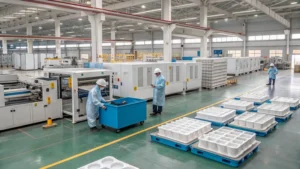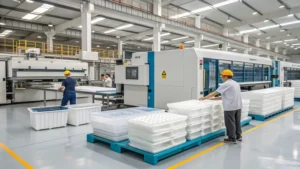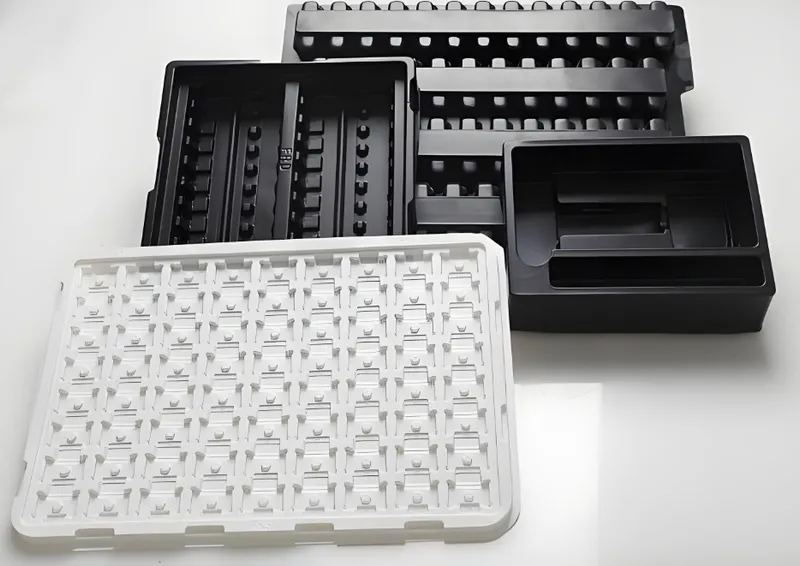
Thermoforming is a versatile manufacturing technique that heats thermoplastic sheets and molds them into a variety of products by applying vacuum or pressure, followed by cooling to set the shape. This process is celebrated for its cost-effectiveness and efficiency, making it a staple in industries such as packaging, automotive, and appliances. However, its suitability depends heavily on the types of products and shapes it can effectively produce.
Thermoforming is ideal for products like packaging trays1, automotive panels2, and appliance liners, with shapes that are relatively shallow, have gentle curves, and avoid sharp corners or undercuts.
In this blog post, we’ll dive into the common products and shapes that thrive with thermoforming3, explore key design considerations, and compare it to other manufacturing methods. Whether you’re designing a new product or optimizing production, this guide will illuminate when thermoforming shines.
Thermoforming is only suitable for simple, shallow parts.False
While thermoforming excels with shallow parts, advanced techniques like pressure forming allow for more complex shapes with intricate details.
Thermoforming is cost-effective for large parts with low to medium production volumes.True
Thermoforming’s lower tooling costs and faster lead times make it ideal for large parts produced in quantities of 250–3000 units annually.
What are the Common Products Made Using Thermoforming?
Thermoforming excels at producing lightweight, durable items with large surface areas, serving a broad range of industries. Its adaptability to both thin- and heavy-gauge materials makes it a go-to for applications where cost and speed outweigh the need for ultra-precise tolerances.
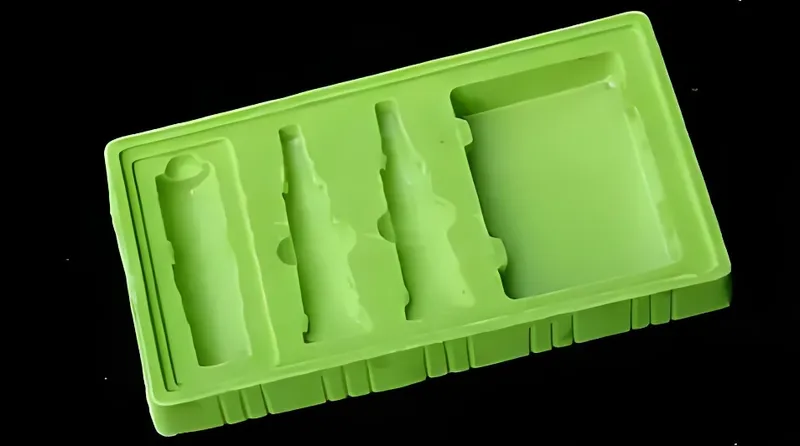
Common thermoformed products include packaging trays, automotive interior panels4, refrigerator liners, and medical device casings, all benefiting from the process’s ability to handle large, shallow designs efficiently.
| Product Type | Industry | Notes |
|---|---|---|
| Packaging Trays | Food, Electronics | Thin-gauge, disposable |
| Automotive Panels | Transportation | Heavy-gauge, durable |
| Appliance Liners | Home Appliances | Heat-resistant, large |
| Medical Casings | Healthcare | Sterile, precise |
Packaging Trays
Thermoforming dominates the production of packaging trays, blister packs, and clamshells, typically using thin-gauge sheets (under 0.060 inches). These items are perfect for high-volume, single-use applications in food and electronics, offering quick production and minimal material use. Companies like Amcor leverage thermoforming for custom, protective packaging solutions.
Automotive Interior Panels
In the automotive sector, thermoforming crafts interior components like door panels and dashboard covers from heavy-gauge sheets5 (over 0.060 inches). These parts demand durability and aesthetics, often enhanced by pressure forming6 for detailed textures. Faurecia uses this process to create lightweight, robust panels meeting rigorous standards.

Appliance Liners
Thermoforming produces seamless liners for refrigerators and ovens, utilizing materials like ABS for heat resistance and insulation. Its ability to form large, single-piece components cost-effectively is a key advantage. Whirlpool relies on this method for efficient appliance manufacturing.
Medical Device Casings
For healthcare, thermoforming creates precise, sterile casings and trays using materials like PETG. Its compatibility with sterilization processes makes it invaluable. Tek Pak specializes in such solutions, ensuring functionality and safety.
Thermoforming is only used for disposable products.False
While packaging is a major application, thermoforming also produces durable goods like automotive parts and appliance components.
Thermoforming can produce parts with high precision and tight tolerances.False
Thermoforming is less precise than injection molding, making it unsuitable for parts requiring very tight tolerances.
What Shapes are Suitable for Thermoforming?
The shapes best suited for thermoforming align with the process’s reliance on stretching a flat sheet over or into a mold. Geometric constraints like depth, angles, and curvature play a critical role in determining feasibility.
Suitable shapes for thermoforming are relatively shallow with gentle curves, a draw ratio up to 3:17, and draft angles of 1.5–5 degrees8 to ensure easy mold release.

Draw Ratio
The draw ratio—mold surface area divided by the original sheet area—should ideally not exceed 3:1. This means a part’s depth shouldn’t be more than three times its width to avoid excessive thinning. For example, a 6-inch deep tray should be at least 2 inches wide.
Draft Angles
Draft angles (1.5–5 degrees) taper side walls to ease part removal from the mold. Deeper features need larger angles—e.g., a 4-inch deep part might require 3 degrees, while a shallow one could use 1.5 degrees.
Avoiding Sharp Corners and Undercuts
Sharp corners thin the material unevenly, and undercuts complicate mold release. Generous radii and simplified designs are preferred, though movable mold parts can handle undercuts at added cost. A tray with rounded edges forms better than one with sharp corners.

Complex Shapes with Pressure Forming
While vacuum forming suits simple shapes, pressure forming uses higher pressure9 for detailed, textured parts—like automotive panels with intricate designs. Ray Products showcases this capability effectively.
Thermoforming can produce parts with undercuts without additional tooling.False
Undercuts typically require movable mold components or secondary operations, increasing complexity and cost.
Pressure forming allows for sharper details than vacuum forming.True
Pressure forming uses higher pressure to push the sheet into the mold, enabling finer details and textures.
What are the Design Considerations for Thermoforming?
Successful thermoforming hinges on thoughtful design to balance manufacturability and performance. Key parameters guide this process.
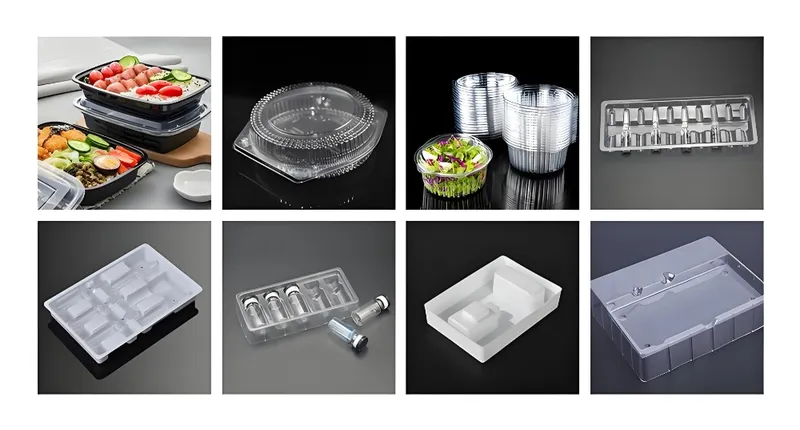
Key design considerations for thermoforming include maintaining a draw ratio of up to 3:1, incorporating draft angles of 1.5–5 degrees, and avoiding sharp corners and undercuts10.
| Design Parameter | Recommended Value | Notes |
|---|---|---|
| Draw Ratio | Up to 3:1 | Avoid excessive thinning |
| Draft Angles | 1.5–5 degrees | Larger for deeper features |
| Corner Radius | ≥ Material thickness | Ensures even distribution |
| Undercuts | Avoid or use movable cores | Increases cost and complexity |
Material Selection
Materials like PET (for packaging clarity), ABS (for impact resistance), and PP (for heat resistance) dictate formability and properties. Choosing the right one aligns with the product’s needs.

Wall Thickness
Thinning occurs in stretched areas, so starting with a thicker sheet (e.g., 0.125 inches for a 0.060-inch final thickness) or adding ribs ensures strength without excess material.
Tolerances
With tolerances around ±0.020 inches, thermoforming suits less precise applications. Tighter specs may require secondary machining, as seen in some medical casings.
Thermoforming can achieve the same precision as injection molding.False
Thermoforming generally offers lower precision, making it unsuitable for parts with very tight tolerances.
Material selection impacts the formability and final properties of thermoformed parts.True
Different materials have varying stretch characteristics, affecting how they form and perform in the final product.
How Does Thermoforming Compare to Other Manufacturing Processes?
Thermoforming’s strengths and limitations become clear when compared to alternatives like injection molding and blow molding.
Thermoforming offers lower tooling costs11 and faster lead times12 than injection molding but is less precise and not suitable for highly complex or hollow parts.

Thermoforming vs. Injection Molding
-
Tooling Costs: Thermoforming’s tooling is 50–90% cheaper—$10,000 vs. $100,000 for a large panel.
-
Lead Times: Weeks vs. months for tool creation.
-
Precision: Injection molding wins for tight tolerances and complexity.
-
Material Use: Thermoforming excels for large, thin-walled parts.
Thermoforming vs. Blow Molding
-
Geometry: Blow molding suits hollow items (e.g., bottles); thermoforming fits open, shallow parts.
-
Efficiency: Thermoforming handles larger parts better.
-
Speed: Both are fast, but thermoforming scales efficiently for flat designs.
Thermoforming is more cost-effective than injection molding for all production volumes.False
For high-volume production, injection molding’s faster cycle times and automation can make it more cost-effective despite higher tooling costs.
Thermoforming can produce hollow parts like bottles.False
Thermoforming is not suitable for hollow, enclosed shapes, which are better produced via blow molding.
Conclusion
Thermoforming shines for producing large, lightweight parts13 like packaging trays, automotive panels, and appliance liners, especially in low to medium volumes. Its cost-effectiveness and speed make it a standout, though it’s less suited for complex, precise, or hollow designs. By mastering suitable products, shapes, and design considerations, you can harness its full potential.
-
Discover the production process and benefits of packaging trays, a key product in thermoforming. ↩
-
Learn about the specific applications of thermoforming in the automotive industry and its advantages. ↩
-
Explore this link to understand the fundamentals of thermoforming and its applications in various industries. ↩
-
Discover the manufacturing process of automotive interior panels and the materials that enhance their durability and design. ↩
-
Learn about heavy-gauge sheets and their critical role in producing durable automotive components, which is essential for understanding material selection in manufacturing. ↩
-
Discover how pressure forming improves the quality and detail of thermoformed products, providing insights into advanced manufacturing techniques. ↩
-
Understanding the draw ratio is crucial for successful thermoforming, ensuring optimal part design and material usage. ↩
-
Draft angles are essential for easy mold release, impacting the efficiency and quality of the final product. ↩
-
Exploring pressure forming reveals advanced techniques for creating intricate designs, enhancing product capabilities. ↩
-
Avoiding sharp corners and undercuts can reduce costs and complexity in production. Learn more about best practices in thermoforming design. ↩
-
Understanding the benefits of lower tooling costs can help businesses optimize their production budgets and improve profitability. ↩
-
Exploring the impact of faster lead times can reveal strategies to enhance production efficiency and customer satisfaction. ↩
-
Discovering the applications of large, lightweight parts can inspire innovative product designs and manufacturing solutions. ↩



